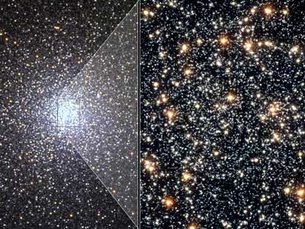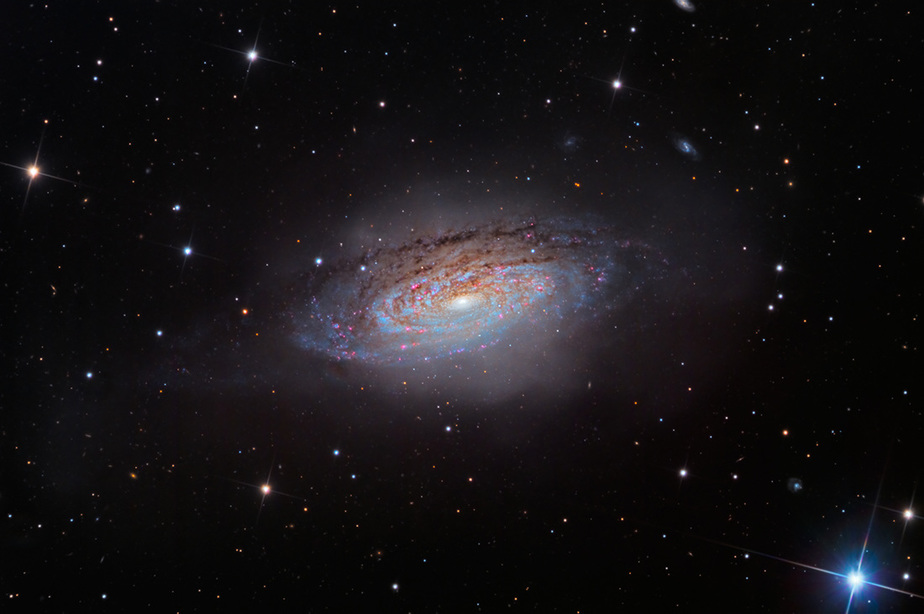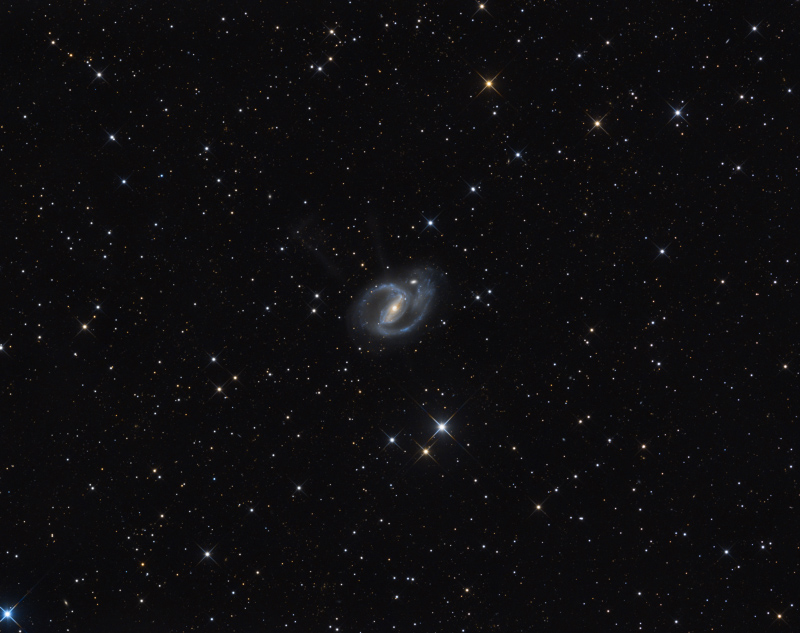Found images: 2016 October
-
starsurfer
- Stellar Cartographer
- Posts: 5409
- Joined: Thu Mar 15, 2012 7:25 pm
Re: HEIC: The Toucan and the Cluster (NGC 299)
I, too, love this image.bystander wrote:The Toucan and the Cluster (NGC 299)
ESA Hubble Picture of the Week | 2016 Oct 17It may be famous for hosting spectacular sights such as the Tucana Dwarf Galaxy and 47 Tucanae (heic1510), the second brightest globular cluster in the night sky, but the southern constellation of Tucana (The Toucan) also possesses a variety of unsung cosmic beauties.
One such beauty is NGC 299, an open star cluster located within the Small Magellanic Cloud just under 200 000 light-years away. Open clusters such as this are collections of stars weakly bound by the shackles of gravity, all of which formed from the same massive molecular cloud of gas and dust. Because of this, all the stars have the same age and composition, but vary in their mass because they formed at different positions within the cloud.
This unique property not only ensures a spectacular sight when viewed through a sophisticated instrument attached to a telescope such as Hubble’s Advanced Camera for Surveys, but gives astronomers a cosmic laboratory in which to study the formation and evolution of stars — a process that is thought to depend strongly on a star’s mass.
It's very tempting trying to date the cluster's age just from the appearance of it. Three red giants - make that supergiants - are very prominent, but there are many smaller hot blue stars in the cluster, too.
The fact that the cluster is very rich means that it is massive. It also means that its most massive stars boast a lot of heft. And that means that these heavyweights will turn into red supergiants in just a few million years.
The Double cluster in Perseus. Photo: Roth Ritter(?).
The reason why the red giants of NGC 299 look so bright is probably a consequence of the filters used for the image, 555 nm (yellow-green) and 814 nm (infrared). Red giants will look bright through both filters, whereas blue stars will look very faint through the 814 nm filter, and not look their best through the 555 nm filter. I'd say that the filters used enhance the red stars and suppress the blue ones.
Nevertheless, I think that NGC 299 is sufficiently similar in appearance to the Double Cluster in Perseus that we might guess that NGC 299 is relatively similar in age to the Double Cluster, ~10-15 million years or so. Maybe NGC 299 is even a little older than the brilliant clusters of Perseus. It does look less massive than NGC 869 and 884, suggesting that its most massive stars are also less massive than the heavyweights of the Double Cluster. Therefore these red giants may also be older and fainter than the sparkling citrines of Perseus.
Ann
Color Commentator
HEIC: Youthful NGC 362
Youthful NGC 362
ESA Hubble Picture of the Week | 2016 Oct 24
ESA Hubble Picture of the Week | 2016 Oct 24
[c][attachment=0]potw1643a[1].jpg[/attachment][/b][/c][hr][/hr]Globular clusters offer some of the most spectacular sights in the night sky. These ornate spheres contain hundreds of thousands of stars, and reside in the outskirts of galaxies. The Milky Way contains over 150 such clusters — and the one shown in this NASA/ESA Hubble Space Telescope image, named NGC 362, is one of the more unusual ones.
As stars make their way through life they fuse elements together in their cores, creating heavier and heavier elements — known in astronomy as metals — in the process. When these stars die, they flood their surroundings with the material they have formed during their lifetimes, enriching the interstellar medium with metals. Stars that form later therefore contain higher proportions of metals than their older relatives.
By studying the different elements present within individual stars in NGC 362, astronomers discovered that the cluster boasts a surprisingly high metal content, indicating that it is younger than expected. Although most globular clusters are much older than the majority of stars in their host galaxy, NGC 362 bucks the trend, with an age lying between 10 and 11 billion years old. For reference, the age of the Milky Way is estimated to be above 13 billion years.
This image, in which you can view NGC 362’s individual stars, was taken by Hubble’s Advanced Camera for Surveys (ACS).
Know the quiet place within your heart and touch the rainbow of possibility; be
alive to the gentle breeze of communication, and please stop being such a jerk. — Garrison Keillor
alive to the gentle breeze of communication, and please stop being such a jerk. — Garrison Keillor
Re: HEIC: Youthful NGC 362
Interestingly, for such a comparatively metal-rich cluster, NGC 362 does contain blue horizontal branch stars. Such stars are an indicator of of an extremely metal-poor composition of the globular that they belong to.bystander wrote:Youthful NGC 362
ESA Hubble Picture of the Week | 2016 Oct 24[c]potw1643a[1].jpg[/c][hr][/hr]Globular clusters offer some of the most spectacular sights in the night sky. These ornate spheres contain hundreds of thousands of stars, and reside in the outskirts of galaxies. The Milky Way contains over 150 such clusters — and the one shown in this NASA/ESA Hubble Space Telescope image, named NGC 362, is one of the more unusual ones.
As stars make their way through life they fuse elements together in their cores, creating heavier and heavier elements — known in astronomy as metals — in the process. When these stars die, they flood their surroundings with the material they have formed during their lifetimes, enriching the interstellar medium with metals. Stars that form later therefore contain higher proportions of metals than their older relatives.
By studying the different elements present within individual stars in NGC 362, astronomers discovered that the cluster boasts a surprisingly high metal content, indicating that it is younger than expected. Although most globular clusters are much older than the majority of stars in their host galaxy, NGC 362 bucks the trend, with an age lying between 10 and 11 billion years old. For reference, the age of the Milky Way is estimated to be above 13 billion years.
This image, in which you can view NGC 362’s individual stars, was taken by Hubble’s Advanced Camera for Surveys (ACS).

M13. Photo: Hubble.

147 Tuc. Photo: Hubble.
NGC 362 may be richer in metals than M13 but poorer in them than 147 Tuc. If NGC 362 is indeed "intermediate", then perhaps it is harder than in M13, but not impossible like in 147 Tuc, for stars to evolve into blue horizontal stars.
Alternatively, perhaps the stars evolve into BHS in NGC 362 as well as in M13, but perhaps they spend less time on the blue horizontal branch the more metal-rich they are.
Ann
Color Commentator
-
starsurfer
- Stellar Cartographer
- Posts: 5409
- Joined: Thu Mar 15, 2012 7:25 pm
Re: Found images: 2016 October
RCW 16
http://cosmicphotos.com/gallery/image.p ... lbum_id=11
Copyright: Jason Jennings This nebula is also catalogued as Sh2-311 and NGC 2467.
http://cosmicphotos.com/gallery/image.p ... lbum_id=11
Copyright: Jason Jennings This nebula is also catalogued as Sh2-311 and NGC 2467.
-
starsurfer
- Stellar Cartographer
- Posts: 5409
- Joined: Thu Mar 15, 2012 7:25 pm
Re: Found images: 2016 October
-
starsurfer
- Stellar Cartographer
- Posts: 5409
- Joined: Thu Mar 15, 2012 7:25 pm
Re: Found images: 2016 October
Rosette Nebula (NGC 2237-9)
http://www.tvdavisastropics.com/astroim ... 00003a.htm
Copyright: Thomas Davis
http://www.tvdavisastropics.com/astroim ... 00003a.htm
Copyright: Thomas Davis
-
starsurfer
- Stellar Cartographer
- Posts: 5409
- Joined: Thu Mar 15, 2012 7:25 pm
Re: Found images: 2016 October
-
starsurfer
- Stellar Cartographer
- Posts: 5409
- Joined: Thu Mar 15, 2012 7:25 pm
Re: Found images: 2016 October
NGC 4214
https://www.noao.edu/image_gallery/html/im1280.html
Copyright: T.A. Rector (University of Alaska Anchorage) and H. Schweiker (WIYN and NOAO/AURA/NSF
https://www.noao.edu/image_gallery/html/im1280.html
Copyright: T.A. Rector (University of Alaska Anchorage) and H. Schweiker (WIYN and NOAO/AURA/NSF
-
starsurfer
- Stellar Cartographer
- Posts: 5409
- Joined: Thu Mar 15, 2012 7:25 pm
-
starsurfer
- Stellar Cartographer
- Posts: 5409
- Joined: Thu Mar 15, 2012 7:25 pm
Re: Found images: 2016 October
NGC 55
http://www.atacama-photographic-observa ... .php?id=53
Copyright: Thierry Demange, Richard Galli and Thomas Petit
http://www.atacama-photographic-observa ... .php?id=53
Copyright: Thierry Demange, Richard Galli and Thomas Petit
-
starsurfer
- Stellar Cartographer
- Posts: 5409
- Joined: Thu Mar 15, 2012 7:25 pm
Re: Found images: 2016 October
Lovely images, starsurfer. I particularly love the picture of galaxies NGC 5363 and 5364 (I knew it is a spiral stunner, but what a fantastic portrait of it this picture is!!!).
Ann
Ann
Color Commentator
-
starsurfer
- Stellar Cartographer
- Posts: 5409
- Joined: Thu Mar 15, 2012 7:25 pm
Re: Found images: 2016 October
B22 and IC 2087
http://www.straightontillmorning.me/Ast ... 9v8twqm/X2
Copyright: Hytham Abu-Safieh IC 2087 is the small reflection nebula and B22 is the larger dark nebula.
http://www.straightontillmorning.me/Ast ... 9v8twqm/X2
Copyright: Hytham Abu-Safieh IC 2087 is the small reflection nebula and B22 is the larger dark nebula.
-
starsurfer
- Stellar Cartographer
- Posts: 5409
- Joined: Thu Mar 15, 2012 7:25 pm
Re: Found images: 2016 October
Taurus Molecular Cloud
http://www.nightpixels.net/ic2087_barnard7.htm
Copyright: Richard Galli Somewhere in this image, B22 and IC 2087 can be found!
http://www.nightpixels.net/ic2087_barnard7.htm
Copyright: Richard Galli Somewhere in this image, B22 and IC 2087 can be found!
-
starsurfer
- Stellar Cartographer
- Posts: 5409
- Joined: Thu Mar 15, 2012 7:25 pm
Re: Found images: 2016 October
-
starsurfer
- Stellar Cartographer
- Posts: 5409
- Joined: Thu Mar 15, 2012 7:25 pm
Re: Found images: 2016 October
NGC 4100
Hooray! Adam Block has posted a new galaxy image, this time of galaxy NGC 4100!
Unfortunately, I haven't found a version of his new image that is even close to being small enough to post here. So instead I'm posting his old picture of NGC 4100 (where he collaborated with Jack Burgess to take the picture).
I think the old image is beautiful in itself. And Adam's (and Jack's) old picture of NGC 4100 is a reminder of Adam Block's amazing dedication to producing great pictures of so many galaxies.
Want to see a picture of an NGC galaxy? Chances are that Adam Block has portrayed it. If he hasn't photographed it, there may very well not exist a good picture of it at all.
Thanks a million for all your splendid galaxy portraits, Adam!
Ann
NGC 4100. Jack Burgess/Adam Block/NOAO/AURA/NSF
Unfortunately, I haven't found a version of his new image that is even close to being small enough to post here. So instead I'm posting his old picture of NGC 4100 (where he collaborated with Jack Burgess to take the picture).
I think the old image is beautiful in itself. And Adam's (and Jack's) old picture of NGC 4100 is a reminder of Adam Block's amazing dedication to producing great pictures of so many galaxies.
Want to see a picture of an NGC galaxy? Chances are that Adam Block has portrayed it. If he hasn't photographed it, there may very well not exist a good picture of it at all.
Thanks a million for all your splendid galaxy portraits, Adam!
Ann
Color Commentator





